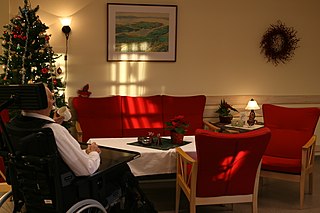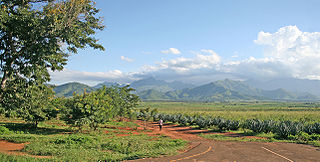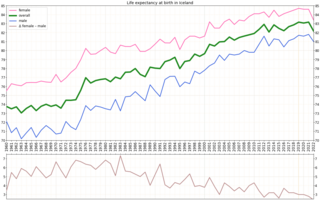
Demographic features of the population of Tanzania include population density, ethnicity, education level, health of the populace, economic status, religious affiliations, and other aspects of the population.

Elderly care, or simply eldercare, serves the needs of old adults. It encompasses assisted living, adult daycare, long-term care, nursing homes, hospice care, and home care.

Morogoro Region is one of Tanzania's 31 administrative regions. The region covers an area of 70,624 km2 (27,268 sq mi). The region is comparable in size to the combined land area of the nation state of Ireland. Morogoro Region is bordered to the north by the Manyara Region and Tanga Region, to the east by the Pwani and Lindi Regions, to the south by the Ruvuma Region and to the west by the Iringa Njombe and Dodoma Regions. The regional capital is the municipality of Morogoro. According to the 2012 national census, the region had a population of 2,218,492.

Ubungo District, officially the, Ubungo Municipal Council is one of five districts of the Dar es Salaam Region of Tanzania. The Kinondoni District and Kibaha of the Pwani Region border the district to the north; the Kisarawe District of Pwani Region borders it to the west; and the Ilala District borders the it to the south and east. The district covers an area of 269.4 km2 (104.0 sq mi). The district is comparable in size to the land area of St. Kitts and Nevis. The administrative seat is Kwembe. The district is home to the University of Dar es Salaam, The Magufuli Bus Terminal, the largest in the country, and Pande Game Reserve the largest protected land area in Dar es Salaam Region. In addition, the district is home to the largest natural gas powered power station, the Ubungo Thermal Power Station and the headquarters of the Tanzania Electric Supply Company Limited (TANESCO). The 2012 National Tanzania Census states the population of the district as 845,368.

The Ministry of Health is the ministry of the Government of Turkey responsible for proposing and executing the government policy on health, planning and providing healthcare and protecting consumers. Likewise, it is responsible for proposing and executing the government policy on social cohesion and inclusion, family, protection of minors, youth and of care for dependent or disabled persons. The Ministry is headquartered in the Bakanlıklar in Ankara.

Tropical diseases, especially malaria and tuberculosis, have long been a public health problem in Kenya. In recent years, infection with the human immunodeficiency virus (HIV), which causes acquired immune deficiency syndrome (AIDS), also has become a severe problem. Estimates of the incidence of infection differ widely.
Health care services in Nepal are provided by both public and private sectors and are generally regarded as failing to meet international standards. Prevalence of disease is significantly higher in Nepal than in other South Asian countries, especially in rural areas. Moreover, the country's topographical and sociological diversity results in periodic epidemics of infectious diseases, epizootics and natural hazards such as floods, forest fires, landslides, and earthquakes. But, recent surge in Non communicable diseases has emerged as the main public health concern and this accounts for more than two-thirds of total mortality in country. A large section of the population, particularly those living in rural poverty, are at risk of infection and mortality by communicable diseases, malnutrition and other health-related events. Nevertheless, some improvements in health care can be witnessed; most notably, there has been significant improvement in the field of maternal health. These improvements include:

As literacy and socioeconomic status improves in Ethiopia, the demand for quality service is also increasing. Besides, changes in the demographic trends, epidemiology and mushrooming urbanization require more comprehensive services covering a wide range and quality of curative, promotive and preventive services.
Healthcare in Finland consists of a highly decentralized three-level publicly funded healthcare system and a much smaller private sector. Although the Ministry of Social Affairs and Health has the highest decision-making authority, specific healthcare precincts are responsible for providing healthcare to their residents as of 2023.

Healthcare in Senegal is a center topic of discourse in understanding the well-being and vitality of the Senegalese people. As of 2008, there was a need to improve Senegal's infrastructure to promote a healthy, decent living environment for the Senegalese.

Healthcare in Denmark is largely provided by the local governments of the five regions, with coordination and regulation by central government, while nursing homes, home care, and school health services are the responsibility of the 98 municipalities. Some specialised hospital services are managed centrally.

Tanzania has a hierarchical health system which is in tandem with the political-administrative hierarchy. At the bottom, there are the dispensaries found in every village where the village leaders have a direct influence on its running. The health centers are found at ward level and the health center in charge is answerable to the ward leaders. At the district, there is a district hospital and at the regional level a regional referral hospital. The tertiary level is usually the zone hospitals and at a national level, there is the national hospital. There are also some specialized hospitals that do not fit directly into this hierarchy and therefore are directly linked to the ministry of health.

A landlocked sub-Saharan country, Burkina Faso is among the poorest countries in the world—44 percent of its population lives below the international poverty line of US$1.90 per day —and it ranks 185th out of 188 countries on UNDP's 2016 Human Development Index .Rapid population growth, gender inequality, and low levels of educational attainment contribute to food insecurity and poverty in Burkina Faso. The total population is just over 20 million with the estimated population growth rate is 3.1 percent per year and seven out of 10 Burkinabe are younger than 30. Total health care expenditures were an estimated 5% of GDP. Total expenditure on health per capita is 82 in 2014.

Iceland has a state-centred, publicly funded universal healthcare system and health insurance that covers the whole population. The number of private providers in Iceland has increased. The healthcare system is largely paid for by taxes (84%) and to some extent by service fees (16%) and is administered by the Ministry of Health. A considerable portion of government spending is assigned to healthcare. There is almost no private health insurance in Iceland and no private hospitals. In very limited cases, access to a private provider can be reimbursement for services provided that the conditions are met.

The 2010 maternal mortality rate per 100,000 births for Tanzania was 790. This is compared with 449 in 2008 and 610.2 in 1990. The UN Child Mortality Report 2011 reports a decrease in under-five mortality from 155 per 1,000 live births in 1990 to 76 per 1,000 live births in 2010, and in neonatal mortality from 40 per 1,000 live births to 26 per 1,000 live births. The aim of the report The State of the World's Midwifery is to highlight ways in which the Millennium Development Goals can be achieved, particularly Goal 4 – Reduce child
Examples of health care systems of the world, sorted by continent, are as follows.
Healthcare in Malawi and its limited resources are inadequate to fully address factors plaguing the population, including infant mortality and the very high burden of diseases, especially HIV/AIDS, malaria and tuberculosis.

Healthcare in Somalia is largely in the private sector. It is regulated by the Ministry of Health of the Federal Government of Somalia. In March 2013, the central authorities launched the Health Sector Strategic Plans (HSSPs), a new national health system that aims to provide universal basic healthcare to all citizens by 2016. Somalia has the highest prevalence of mental illness in the world, according to the World Health organization. Some polls have ranked Somalis as the happiest people in Sub-Saharan Africa.
A day hospital is an outpatient facility where patients attend for assessment, treatment or rehabilitation during the day and then return home or spend the night at a different facility. Day hospitals are becoming a new trend in healthcare. The number of surgical procedures carried out on a same-day basis has markedly increased in EU countries and USA. New medical technologies such as less invasive surgeries and better anesthetics have made this development possible. These innovations improve patient safety and health outcomes. Shortening the length of stay in hospital reduces the cost per intervention and increases the number of procedures performed. Less hospital beds are necessary, and they are often replaced by day hospital chairs that enable admission and preparation of the patient before surgery and recovery after surgery.

Healthcare in Angola consists of a network of hospitals, clinics, and dispensaries.















